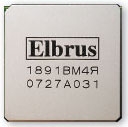From WikiChip
Difference between revisions of "MCST/elbrus"
(image) |
m |
||
| Line 15: | Line 15: | ||
| proc = 130 nm | | proc = 130 nm | ||
| tech = | | tech = | ||
| − | | clock | + | | clock = 300 MHz |
| − | |||
| package = HFCBGA 900 | | package = HFCBGA 900 | ||
| socket = Surface mount | | socket = Surface mount | ||
Latest revision as of 13:51, 14 November 2019
| Elbrus | |

| |
| Developer | MCST |
| Type | Microprocessors |
| Introduction | 2005 (announced) 2007 (launch) |
| Architecture | Elbrus (VLIW) |
| Word size | 64 bit 8 octets
16 nibbles |
| Process | 130 nm 0.13 μm
1.3e-4 mm |
| Clock | 300 MHz |
| Package | HFCBGA 900 |
| Socket | Surface mount |
| Succession | |
| → | |
| Elbrus-S | |
Elbrus (rus. Эльбрус, code designation: 1891ВМ4Я) is an universal microprocessor with the Elbrus architecture, developed by the russian company MCST in 2005.
Overview[edit]
The «Elbrus» microprocessor is a single core VLIW microprocessor providing parallel execution of 23 instructions per cycle.
Specification:
- Built-in first level cache memory - 128 KB (64 KB for data and 64 KB for instructions)
- Built-in overall second level cache memory - 256 KB
- Supported type of RAM - DDR2
The average power dissipation is 6 watts. The microprocessor is intended for use in servers and computing systems[1][2].
References[edit]
Facts about "MCST/elbrus"
| designer | MCST + |
| first announced | 2005 + |
| first launched | 2007 + |
| full page name | MCST/elbrus + |
| instance of | microprocessor family + |
| main designer | MCST + |
| name | Elbrus + |
| package | HFCBGA 900 + |
| process | 130 nm (0.13 μm, 1.3e-4 mm) + |
| socket | Surface mount + |
| word size | 64 bit (8 octets, 16 nibbles) + |